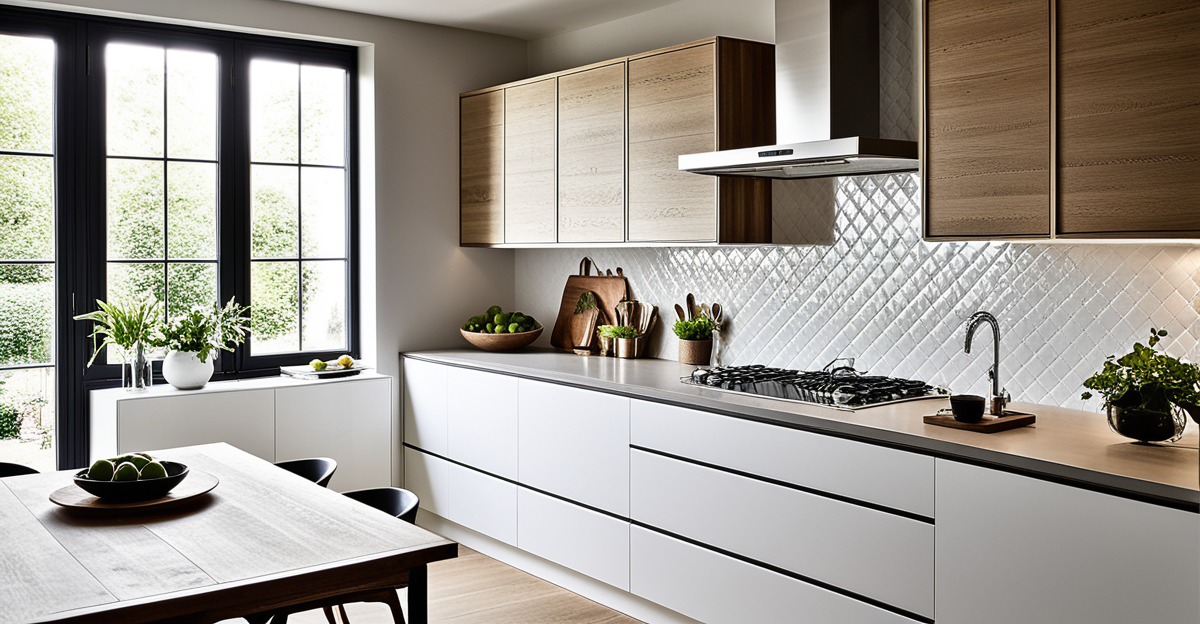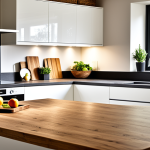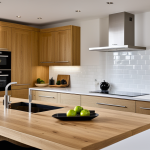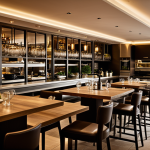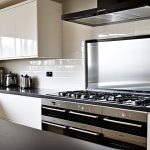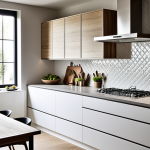Design Principles for Small Kitchens
Creating an effective small kitchen design requires a careful balance between functionality and style. When considering small kitchen design principles, space optimization is paramount. Functionality in the kitchen ensures that all daily tasks can be performed efficiently, even in a limited area. This means every corner should be utilized, and every piece of furniture or appliance should serve multiple purposes.
Balancing modern kitchen aesthetics with practicality is a delicate task. Aesthetics should not overshadow functionality, nor should practicality compromise the look. It’s essential to incorporate elements that are both visually pleasing and efficient in space usage. This could involve selecting sleek finishes that are easy to clean or choosing foldaway tables and chairs that can be stowed neatly away when not in use.
Also to discover : What Are the Essential Tips for Designing a Slim Kitchen in the UK?
One of the most effective methods to optimize space is by utilizing vertical spaces. Vertical storage solutions, such as tall cabinets or hanging racks, can significantly increase storage capacity without taking up valuable floor space. Additionally, these options can add an element of design to your kitchen, transforming walls into aesthetically pleasing storage areas that also organize kitchen tools and ingredients efficiently.
By applying these thoughtful design principles, a small kitchen can become a paragon of efficiency and style, where every element from layout to finish serves a functional and aesthetic purpose.
Also to see : How Can UK Kitchens Be Designed for Enhanced Efficiency?
Space-Saving Solutions
When it comes to designing a small kitchen, integrating space-saving solutions is crucial for both functionality and style. One effective strategy is to incorporate multifunctional furniture that serves multiple purposes. For instance, a kitchen island that doubles as a dining table or a storage unit caters to diverse needs without consuming extra space. This approach not only optimizes the available area but also maintains a sleek, modern appearance.
Moreover, the selection of compact appliances tailored for small kitchens can dramatically enhance the utility. These appliances often come in streamlined designs, perfect for squeezing into tight spots. For example, a two-burner stove or a mini dishwasher can free up significant counter space while fulfilling essential kitchen functions.
Hidden spaces also offer clever storage solutions. Utilize areas such as the insides of cabinet doors or the space above cabinets for storing seldom-used items. Implementing pull-out shelves and drawers can maximize access to stored goods, ensuring every inch is put to good use. By thoughtfully employing these techniques, you transform a compact kitchen into a highly efficient, aesthetically pleasing space that meets all culinary needs.
Recommended Materials for Small Kitchens
In small kitchens, the choice of kitchen materials plays a crucial role in enhancing both functionality and aesthetic appeal. Selecting the right surfaces and finishes can significantly impact the overall design and usability.
Countertops
Countertops in small kitchens should be both durable and lightweight to ensure they withstand daily use while not overwhelming the space. Materials like quartz and granite provide robust surfaces that resist scratches and stains. For a more eco-friendly option, consider bamboo or recycled glass, which offer durability while contributing to a sustainable kitchen design.
Cabinets
When it comes to cabinets, opting for lightweight yet sturdy materials is key. Plywood and medium-density fiberboard (MDF) are excellent choices, offering a balance between strength and weight. These materials can support the weight of stored items without adding unnecessary bulk. Cabinet finishes such as high-gloss or reflective surfaces can further enhance space perception by reflecting light, making the kitchen feel larger and more open.
Flooring
Flooring should combine durability with style, offering a foundation that withstands kitchen activity while enhancing design. Vinyl and laminate flooring are popular due to their resilience and water resistance. These materials mimic more expensive finishes like wood or stone, providing a cost-effective solution without compromising on aesthetics. Additionally, lighter shades in flooring help to create an illusion of a larger, airy space, further augmenting the overall design of a small kitchen.
Color Schemes for Modern Kitchen Aesthetics
In small kitchen design, the right color palette significantly impacts both the feel and functionality of the space. Carefully chosen colors can create the illusion of a larger area, increase light reflection, and contribute to a cohesive ambiance.
Impact of Color on Space and Light
Colors play a pivotal role in how space is perceived. Light, neutral tones are often recommended as they reflect more light and make rooms appear more spacious. This is particularly beneficial in tight kitchens where maximizing the sense of openness is crucial. White, soft grey, and pastel shades are popular, often enhancing modern kitchen aesthetics by providing a clean, cohesive look while optimizing perceived space.
Recommended Color Palettes
For a contemporary and cohesive design, a combination of light tones with pops of vibrant colors can be quite effective. For example, a predominantly white kitchen can be accentuated with navy blue or olive green accents—perhaps on a backsplash or a feature wall—to add interest without overwhelming the space. This balanced approach respects space limitations while injecting personality into the kitchen.
Techniques for Cohesion and Interest
To ensure cohesiveness, repeat shades throughout the kitchen in different elements—such as cabinetry, walls, and accessories. Incorporate texture and pattern through materials like tiles or wood grain to introduce depth and detail. Using these techniques not only unifies the design but also ensures that the kitchen feels inviting and deliberately crafted, despite its compact size.
Examples of Successful Small Kitchen Layouts
Exploring different small kitchen layouts can inspire efficient and stylish designs. This section showcases practical examples, each tailored to maximize limited space without sacrificing functionality or aesthetics.
U-Shape Layout
The U-shape layout is ideal for optimizing workspace in compact kitchens. This configuration surrounds the cook with counter and storage space on three sides. It allows for efficient movement, easy access to appliances, and a continuous flow in the kitchen. For those wondering whether this layout is suitable for tiny spaces, the answer is affirmative. The closed-off ends make this an excellent design for areas where every inch counts, and maximizing surface area takes precedence.
L-Shape Layout
An L-shape layout is perfect for open-plan areas, forming a natural division between the kitchen and surrounding spaces. This design uses two adjacent walls for cabinets, counters, and appliances, creating a flexible working triangle for cooking, cleaning, and preparation. To make the most of this layout in small kitchens, consider incorporating overhead storage and open shelves to maintain an airy feel.
Galley Layout
The galley layout is a classic choice for narrow spaces, featuring parallel counters and ample storage. This setup creates a corridor-like kitchen, perfect for one-cook households needing efficient workflow. The galley’s linear design ensures everything is within reach. To further optimize, consider utilizing one wall for higher cabinets and the opposite for under-counter storage, maintaining a clear and navigable path.
These examples illustrate how effectively choosing the right layout can transform compact spaces into functional and beautiful kitchens, meeting both practical needs and aesthetic desires.
Visual Aids and Expert Recommendations
Incorporating kitchen design visuals can profoundly enhance your understanding of how to maximize small kitchen spaces. Visual aids, such as infographics and detailed images, illustrate effective design strategies and help you visualize the potential of your kitchen layout. These tools not only simplify complex spatial arrangements but also provide clear examples of implementing key concepts like space optimization and multifunctional furniture.
To assist with planning, design tools and software have become invaluable assets. Programs like SketchUp or RoomSketcher allow users to create digital models of their kitchen, experimenting with different layouts and materials before making any physical changes. Such tools are especially beneficial in small spaces where every inch must be thoughtfully planned and utilized.
Moreover, insights from design professionals can offer practical advice on approaching small kitchen challenges. Experts often recommend prioritizing critical aspects like vertical storage and compact appliances to maintain functionality without compromising style. Their tips can ensure that even the smallest kitchens meet modern standards of aesthetics and efficiency.
By utilizing these resources, homeowners can effectively plan and execute a seamless, well-organized kitchen design, ensuring both design functionality and modern aesthetics are met.

